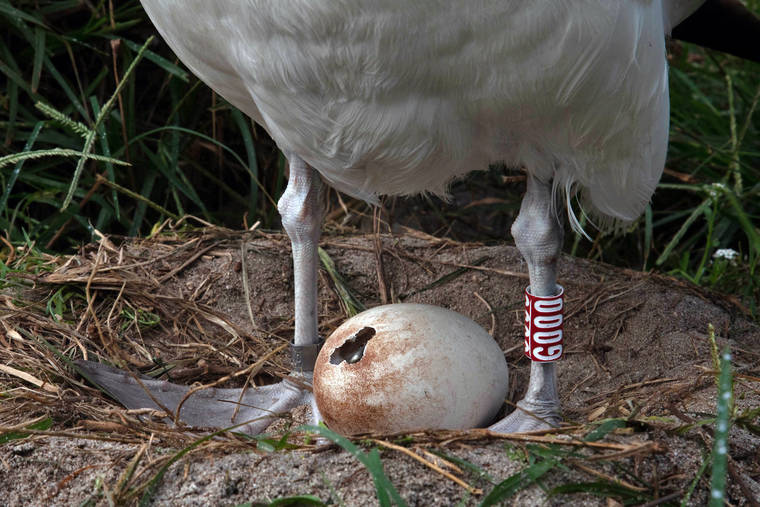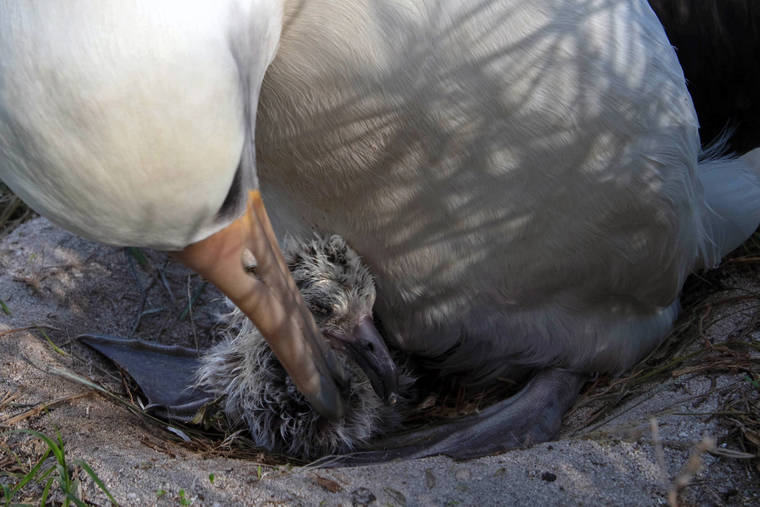Septuagenarian Laysan albatross Wisdom hatches new chick on Midway

COURTESY JON BRACK/FRIENDS OF MIDWAY ATOLL NATIONAL WILDLIFE REFUGE
Wisdom’s chick was seen pipping, Jan. 30. Pipping is when a young bird begins to crack the shell of the egg when hatching. Sometimes the process can take multiple days.

COURTESY JON BRACK/FRIENDS OF MIDWAY ATOLL NATIONAL WILDLIFE REFUGE
Wisdom’s newest chick, seen on Feb. 2, shortly after hatching, with its dad, Akeakamai.


Wisdom the Laysan albatross has done it again.
The world’s oldest known banded wild bird hatched a new chick on Monday at Midway Atoll, wildlife officials announced today. Biologists first observed the egg pipping — or shell cracking — on Jan. 29, and the chick hatched several days later on the first of February.
The chick appears to be healthy and doing well.
The return of Wisdom Opens in a new tab, at least 70 years old, and her mate, Akeakamai, to their nest site at Midway Atoll National Wildlife Refuge Opens in a new tab in late November marked an exciting milestone for wildlife officials, who anticipated they might hatch another chick.
“Each year that Wisdom returns, we learn more about how long seabirds can live and raise chicks,” said U.S. Fish and Wildlife Service biologist Beth Flint. “Her return not only inspires bird lovers everywhere, but helps us better understand how we can protect these graceful seabirds and the habitat they need to survive into the future.”
The USFWS initially listed the lifespan of a Laysan albatross at 12 to 40 years, so Wisdom’s longevity and productivity year after year outweighs expectations, providing a beacon of hope for her species.
Don't miss out on what's happening!
Stay in touch with breaking news, as it happens, conveniently in your email inbox. It's FREE!
Millions of albatrosses return every fall to Midway at Papahanaumokuakea Marine National Opens in a new tabMonument Opens in a new tab to reunite with their mate at their nesting sites. Wisdom and Akeakamai have been hatching and raising chicks together since at least 2012, when biologists first banded Akeakamai.
Biologists first banded Wisdom in 1956, and estimate she has hatched between 30 to 36 chicks in her lifetime — an amazing feat — and probably with more than one mate.
Albatross do not typically lay eggs every year and when they do, they lay only one — so each chick that hatches and survives to adulthood makes a difference for the future of the albatross population.
The incubation period for an albatross egg is typically 65 days, and most chicks on Midway hatch in January or February. They generally fledge, or fly for the first time, in June and July.
The albatross pair takes turns incubating and feeding the chick.
Midway Opens in a new tab, one of the oldest atoll formations in the world, provides a refuge for roughly 70% of the world’s Laysan albatrosses and 40% of black-footed albatrosses, along with endangered short-tailed albatrosses and 20 other bird species.
To date, over 275,000 albatrosses have been banded at Midway, offering scientists data to better understand the life cycles and migration patterns of birds. Biologists and volunteers are not only working to restore the habitat for seabirds at Midway, but to remove threats like invasive predators.



